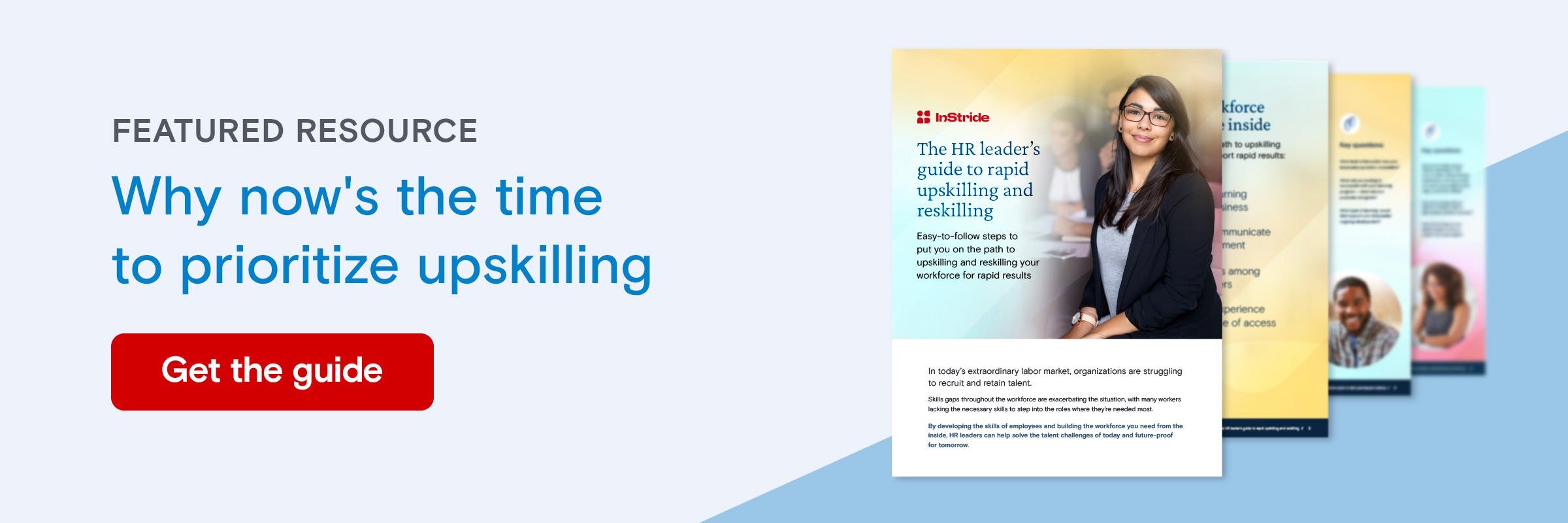There are a variety of reasons why people leave the workforce for extended periods. For many who have been in this position, the idea of re-entering the working world with a large gap on a resume can be daunting.
While it’s true that skills can suffer from a prolonged professional break, this shouldn’t be a factor that keeps high-potential talent from stepping back into a traditional career. Organizations should consider reassessing their perspective on resume gaps, viewing them not as red flags signaling a regression in experience, but rather as indicators of the level of training and skill-building an individual may need to catch up with the current demands of their role.
This is the thinking behind returnships which are programs designed to help individuals rejoin the workforce after prolonged absences. In this article, we’ll share more about returnship programs and their benefits, as well as real-world examples and tips on how to create one for your organization that has a meaningful, lasting impact.
What is a returnship program?
A returnship, also referred to as a return-to-work program, is an employment program that offers short-term work opportunities for mid-career individuals returning to the workforce after a long absence. Not to be confused with an internship that typically involves gaining work experience early in a career, a returnship is designed as a bridge back into an individual’s career.
The content of a returnship typically offers on-the-job training, upskilling, reskilling and other forms of learning. Completion of a returnship may result in a full-time job offer depending on the performance of the employee and the capacity of the organization.
Returnship programs are generally designed for individuals who leave their jobs voluntarily and not due to an issue of performance or competency. Candidates who qualify for returnships are generally absent for several years, often – but not always – to pursue education, care for family or tend to another life event that prevents them from working.
How do returnships work?
Companies typically stipulate a set of criteria that candidates must meet to qualify for a returnship program. Most commonly, businesses require applicants to have:
- A minimum amount of training and experience in the specific position
- A minimum number of time off of work
- Critical skills or understanding in the position or field
Some returnships may also be specifically designed for certain demographics as a point of accessibility and equity.
If they meet the criteria, candidates are welcome to apply for the returnship. Following this, they will be hired for a period of time, typically anywhere between 4-12 weeks. During this time, they receive training, on-the-job learning, access to upskilling or reskilling opportunities, and often direct mentorship to help re-acquaint them with work.
Following this returnship period, candidates may apply for a full-time position within the same company, or use the experience gained in the returnship as a resume booster when applying elsewhere.
Benefits of returnship programs
A returnship program offers significant benefits to both organizations and the individuals they are designed for.
For employees
A returnship program offers employees the benefit of:
- Opportunity to reenter the workforce without needing to start from scratch in an entry-level role
- Access to resources that offer career guidance and support skill-building
- Potential for full-time employment following successful completion of a returnship program
- Job-relevant experience
- Transitional pay and benefits
- Ability to explore career interests across different areas of the business
For employers
A returnship program offers employers the benefit of:
- Access to an experienced, skilled talent pool
- Reskilling talent to fill job openings
- Reducing hiring risks by having the opportunity to consider returnship performance before extending an offer
- Foster engagement by highlighting your commitment to supporting employees with non-traditional career paths
Companies that offer returnship programs
Let’s look at a few examples of industry-leading organizations with returnship programs.
- Amazon
The retail giant offers a longer 16-week returnship largely aimed towards work-from-home positions. Offering benefits to returnship participants and a clear pathway towards employment following completion of the program, Amazon includes practical project development, classroom training and one-on-one mentorships as critical aspects of its offering. - PayPal
PayPal’s returnship program is specifically designed for women returning to work. The company offers either a 16-week paid training program or a special skills boot camp that focuses on building new and relevant skills for experienced workers. - Goldman Sachs
This is a uniquely in-person program offered at a few of the many nationwide company offices. The application opens once annually, allowing candidates to submit themselves for a 6-month-long paid program that involves advanced job training and peer networking.
Tips for building a returnship program
Organizations already offering comprehensive learning and career development opportunities have all the infrastructural elements they need in place to support a successful returnship program. However, the unique nature of returnship programs does require additional considerations beyond your traditional L&D strategy. Here are a few practical steps to get your returnship program up and running.
- Get clear on your objectives
As with any new people initiative, it’s imperative to start by defining clear objectives for your program. This should include high-level business objectives such as filling job vacancies, boosting employee engagement and accelerating workplace DEI. - Milestones for participant success
There should be clear criteria for individual progression and success within the program. This can include outlining specific skills and competencies that need to be developed or training milestones that should be achieved. It’s also important to strategize and document what qualifies a returnship program participant to be considered for a full-time offer. - Implement program content and other resources
Nailing down objectives and criteria for success will help you to take the next step — identifying the appropriate training, education and mentorship resources needed for your returnship program. No two job functions are the same, so it’s important to offer a range of learning opportunities that span the needs of all the roles and varying levels of experience that you’re targeting. - Don’t overlook continuous skills development
For the people who secure a full-time position, it’s critical to also consider what happens after the returnship. Learning shouldn’t stop. Ensure they have access to L&D opportunities that enable them to continue their learning journey and set them up for long-term success with your company. This can include accessible training, upskilling/reskilling resources, access to certification or degree programs, and support through mentorship.
Investing in returnships is a win-win
Returnship programs result in positive outcomes for all involved. By offering training and support to people who are rejoining the workforce, businesses can unlock a vast reservoir of high-potential talent. At the same time, this helps employees to resharpen their skills and set them up for long-term growth. This contributes to an organization’s overall diversity, innovation and success and, ultimately, contributes to a more inclusive and dynamic work environment.
Explore more L&D resources: An L&D strategy can only be effective if it’s accessible to the individuals who need it most. Download this e-book to learn accessibility best practices for your employee education program.


